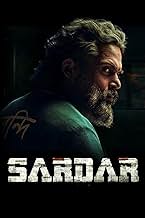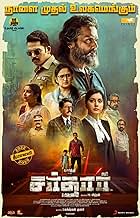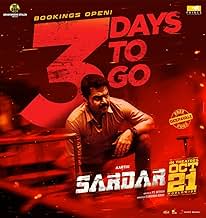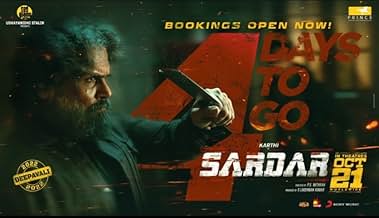Sardar
- 2022
- 2 h 46 min
AVALIAÇÃO DA IMDb
7,5/10
8,2 mil
SUA AVALIAÇÃO
Adicionar um enredo no seu idiomaA spy, who is estranged from his family due to a mission, suddenly meets his police officer son.A spy, who is estranged from his family due to a mission, suddenly meets his police officer son.A spy, who is estranged from his family due to a mission, suddenly meets his police officer son.
- Prêmios
- 1 indicação no total
K S Krishnan
- Dr. Kuppusamy
- (as K.S. Krishnan)
Chunky Pandey
- Maharaj Rathore
- (as Chunky Panday)
Rithu Rocks Rithvik
- Timothy akak Timmy
- (as Rithvik)
Enredo
Você sabia?
- Erros de gravaçãoThe way a Morse Code signal is being transmitted through telephone ringing would require more time than what is shown. The time to redial and reconnect should have been considered. Ringing on the dialed number end cannot be controlled like this.
- Versões alternativasThe UK release was cut, the distributor chose to make cuts to scenes of strong violence in order to obtain a 12A classification. An uncut 15 classification was available.
Avaliação em destaque
Despite being hampered by commercial roadblocks, Sardar still succeeds in carrying out such a mammoth project, thanks to the brilliance in the screenplay by P. S. Mithran. Backed up by some scintillating background score from G V Prakash Kumar, this Karthi starter has much more to offer than just being any other spy thrillers out there.
Note - Though I will be discussing the screenplay techniques used in the feature, I will refrain from any kind of spoilers, as much as possible. Happy reading!
Prelude - The man behind the (Iron) Screen
Usually, after witnessing any feature in a theatre, people flock out, in-order to flock to a different kind of medium - Social Media. However, after this particular feature, the way we see and use mobile phones, let alone social media, was changed. The feature is Irumbu Thirai (Iron Screen) and the man who created the change is P. S. Mithran. The way the seriousness of the theme was handled was commended by many.
Although his next feature - Hero - was as ambitious as his first, it did not just strike a chord with the audience and ended up with a lukewarm response. Nevertheless, the treatment was more than enough for P. S. Mithran to earn a spot on my list of "Screenplay writers to watch out for".
Yes, he is a commercial director. Yes, the initial 30 minutes will have a mandatory "love" portion for the lead character (aka Hero). And Yes, the lead character ultimately wins! In spite of having such a stereotypical storyline in both of his previous films, P. S. Mithran stood out with the way he presented them, in his different approach to creating such thrillers. This was purely the only motive for me to watch his next feature - Sardar.
Screenplay - The Game Changer
If there is one element that changed the fate of Sardar, it's the screenplay. Though it follows a three-arc structure on its base, there were other techniques interlaced to provide a brilliant structure to the grandeur nature of the project. The screenplay is fairly linear in nature but employs a kind of Double Journey structure, whenever an emotional/psychological high moment occurs. Sometimes it employs flashbacks and sometimes it's flashforwards, but the emotion and the adrenaline rush stay the same throughout such sequences. It reminded me of Godfather Part 2 (1974), which had parallel dramas running - prequel and sequel to the Godfather (1972), which shows the rise of both the son and his father in different timelines (co-incidental?!).
Let me tell you an example. There is this sequence, where Vijay Prakash (Karthi) imagines himself in place of a kid, striking an emotional chord with him. The whole sequence panned out brilliantly from script to screen, thanks to the amalgamating work from P. S. Mithran (Writer/Director), George C. Williams (Cinematographer), Ruben (Editor), and G. V. Prakash Kumar (Music). The use of flashback was crisp, quick and highly effective, and was also exhibiting the dual nature of the story itself!
Starting from the subtext of the film (Once a spy, always a spy), to how good a spy should be, the feature is filled with setups and payoffs which are well written and used at places in a striking manner. Along with effective uses of callbacks, the screenplay draws audience attention to details to just the right amount, refraining from creating complex sub-plots, and once such callback sequence hits the screen, it for sure delivers some pleasure hormones to our brain cells!
But, with the advent of OTT, most of us are aware of such spy thriller genre. Hence, I will not be exaggerating if I say that we all know what happens next. But, it's the how that matters! That's where the use of Fabula and syuzhet comes in, which was used effectively in the genre of crime thrillers/investigations. Fabula is the raw material of a story and syuzhet is the way it was organised, and it is one of the commonly employed techniques were one witness the result first and then to the "how" part, later. Employing the Flashforward technique in combination with the Fabula and syuzhet, P. S. Mithran created a hybrid one where the screenplay is pretty linear and non-complex, and yet flashforwards to offer a high point just before an emotional high point occurs - the Action Blocks.
Action Blocks - Compelling one
For any spy thriller, it is a taken that the protoganist can do anything out of ordinary. He could smash multiple persons at once, handle extreme machineries, and carry out stunts that may be impossible in real world, with Beast and Vikram being prime examples. However, Sardar sets something different. By employing the screenplay techniques that were discussed earlier, the action blocks were used as a medium of storytelling, than just being a reason to show the muscle power of the lead. The execution was more than enough to pump enough adrenaline into the audience, to sustain their attention until such sequence occurs next. Hence, one will forgo the illogical sequences that might pop up here and there. Still, there are certain misses that P. S. Mithran could've caught earlier.
The Misses
As the feature dives into the world of Vijay Prakash, we witness a certain conversation between a (supposed) IT wing and a politician from a certain political party, which sort of provides the introduction for the lead (Vijay Prakash). However, we see no closing act for these people, and not even callbacks at any point of time. For a movie that used callbacks such effectively, this sequence was certainly a disappointment.
The same goes for the dreamy song sequence between the lead characters, Vijay Prakash and Shalini (Raashi Khanna). What could have been a song with just montage sequences, imparted the unwanted sequences with costumes and set pieces that are no way connected to this earth, literally!
Is it worth it?
Unlike Vikram, which was filled with guns, bullets, blood and action sequences, Sardar shows you the other side of being a spy. It lets us explore the downside of it, the after-effects, the repercussion it could've on a person's life. Though sounding more like a family drama, Sardar is still a compelling watch in the genre of a spy thriller, which reminds us the famous quote from Alfred Hitchcock.
"To make a great film, you need three things - the script, the script and the script."
Note - Though I will be discussing the screenplay techniques used in the feature, I will refrain from any kind of spoilers, as much as possible. Happy reading!
Prelude - The man behind the (Iron) Screen
Usually, after witnessing any feature in a theatre, people flock out, in-order to flock to a different kind of medium - Social Media. However, after this particular feature, the way we see and use mobile phones, let alone social media, was changed. The feature is Irumbu Thirai (Iron Screen) and the man who created the change is P. S. Mithran. The way the seriousness of the theme was handled was commended by many.
Although his next feature - Hero - was as ambitious as his first, it did not just strike a chord with the audience and ended up with a lukewarm response. Nevertheless, the treatment was more than enough for P. S. Mithran to earn a spot on my list of "Screenplay writers to watch out for".
Yes, he is a commercial director. Yes, the initial 30 minutes will have a mandatory "love" portion for the lead character (aka Hero). And Yes, the lead character ultimately wins! In spite of having such a stereotypical storyline in both of his previous films, P. S. Mithran stood out with the way he presented them, in his different approach to creating such thrillers. This was purely the only motive for me to watch his next feature - Sardar.
Screenplay - The Game Changer
If there is one element that changed the fate of Sardar, it's the screenplay. Though it follows a three-arc structure on its base, there were other techniques interlaced to provide a brilliant structure to the grandeur nature of the project. The screenplay is fairly linear in nature but employs a kind of Double Journey structure, whenever an emotional/psychological high moment occurs. Sometimes it employs flashbacks and sometimes it's flashforwards, but the emotion and the adrenaline rush stay the same throughout such sequences. It reminded me of Godfather Part 2 (1974), which had parallel dramas running - prequel and sequel to the Godfather (1972), which shows the rise of both the son and his father in different timelines (co-incidental?!).
Let me tell you an example. There is this sequence, where Vijay Prakash (Karthi) imagines himself in place of a kid, striking an emotional chord with him. The whole sequence panned out brilliantly from script to screen, thanks to the amalgamating work from P. S. Mithran (Writer/Director), George C. Williams (Cinematographer), Ruben (Editor), and G. V. Prakash Kumar (Music). The use of flashback was crisp, quick and highly effective, and was also exhibiting the dual nature of the story itself!
Starting from the subtext of the film (Once a spy, always a spy), to how good a spy should be, the feature is filled with setups and payoffs which are well written and used at places in a striking manner. Along with effective uses of callbacks, the screenplay draws audience attention to details to just the right amount, refraining from creating complex sub-plots, and once such callback sequence hits the screen, it for sure delivers some pleasure hormones to our brain cells!
But, with the advent of OTT, most of us are aware of such spy thriller genre. Hence, I will not be exaggerating if I say that we all know what happens next. But, it's the how that matters! That's where the use of Fabula and syuzhet comes in, which was used effectively in the genre of crime thrillers/investigations. Fabula is the raw material of a story and syuzhet is the way it was organised, and it is one of the commonly employed techniques were one witness the result first and then to the "how" part, later. Employing the Flashforward technique in combination with the Fabula and syuzhet, P. S. Mithran created a hybrid one where the screenplay is pretty linear and non-complex, and yet flashforwards to offer a high point just before an emotional high point occurs - the Action Blocks.
Action Blocks - Compelling one
For any spy thriller, it is a taken that the protoganist can do anything out of ordinary. He could smash multiple persons at once, handle extreme machineries, and carry out stunts that may be impossible in real world, with Beast and Vikram being prime examples. However, Sardar sets something different. By employing the screenplay techniques that were discussed earlier, the action blocks were used as a medium of storytelling, than just being a reason to show the muscle power of the lead. The execution was more than enough to pump enough adrenaline into the audience, to sustain their attention until such sequence occurs next. Hence, one will forgo the illogical sequences that might pop up here and there. Still, there are certain misses that P. S. Mithran could've caught earlier.
The Misses
As the feature dives into the world of Vijay Prakash, we witness a certain conversation between a (supposed) IT wing and a politician from a certain political party, which sort of provides the introduction for the lead (Vijay Prakash). However, we see no closing act for these people, and not even callbacks at any point of time. For a movie that used callbacks such effectively, this sequence was certainly a disappointment.
The same goes for the dreamy song sequence between the lead characters, Vijay Prakash and Shalini (Raashi Khanna). What could have been a song with just montage sequences, imparted the unwanted sequences with costumes and set pieces that are no way connected to this earth, literally!
Is it worth it?
Unlike Vikram, which was filled with guns, bullets, blood and action sequences, Sardar shows you the other side of being a spy. It lets us explore the downside of it, the after-effects, the repercussion it could've on a person's life. Though sounding more like a family drama, Sardar is still a compelling watch in the genre of a spy thriller, which reminds us the famous quote from Alfred Hitchcock.
"To make a great film, you need three things - the script, the script and the script."
- Alfred Hitchcock, known as the "Master of Suspense"
- naveensankaran18
- 29 de out. de 2022
- Link permanente
Principais escolhas
Faça login para avaliar e ver a lista de recomendações personalizadas
- How long is Sardar?Fornecido pela Alexa
Detalhes
Bilheteria
- Faturamento bruto mundial
- US$ 2.497.844
- Tempo de duração2 horas 46 minutos
- Cor
- Mixagem de som
- Proporção
- 2.39 : 1
Contribua para esta página
Sugerir uma alteração ou adicionar conteúdo ausente


![Assistir a Trailer [OV]](https://m.media-amazon.com/images/M/MV5BNjIxMjFjNjctZDAyNy00MjVmLTg3ODYtNGQ0NjRjZmVhZTBhXkEyXkFqcGdeQXRyYW5zY29kZS13b3JrZmxvdw@@._V1_QL75_UX500_CR0)


















